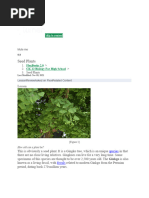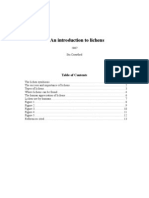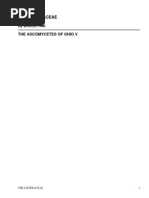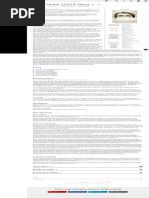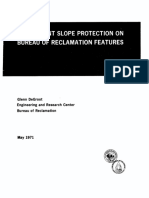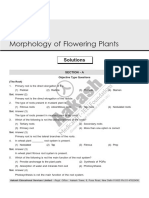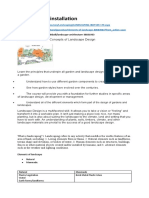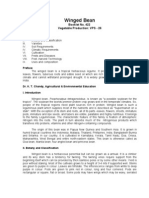Juncus
Juncus
Uploaded by
moresubscriptionsCopyright:
Available Formats
Juncus
Juncus
Uploaded by
moresubscriptionsCopyright
Available Formats
Share this document
Did you find this document useful?
Is this content inappropriate?
Copyright:
Available Formats
Juncus
Juncus
Uploaded by
moresubscriptionsCopyright:
Available Formats
Not logged in Talk Contributions Create account Log in
Article Talk Read Edit View history Search Wikipedia
Juncus
From Wikipedia, the free encyclopedia
Main page Juncus is a genus of monocotyledonous flowering plants, commonly known as rushes. It is the
Juncus
Contents largest genus in the family Juncaceae, containing around 300 species.[2]
Featured content
Current events Contents [hide]
Random article
1 Description
Donate to Wikipedia
2 Distribution and ecology
Wikipedia store
3 Fossil record
Interaction 4 Classification
Help 4.1 Species
About Wikipedia 5 References Habit of J. conglomeratus
Community portal 6 External links
Recent changes
Contact page
Tools
Description [ edit ]
What links here Rushes of the genus Juncus are herbaceous plants that superficially resemble grasses or
Related changes sedges.[3] They have historically received little attention from botanists; in his 1819 monograph,
Upload file
James Ebenezer Bicheno described the genus as "obscure and uninviting".[4]
Special pages Flower of J. squarrosus
Permanent link The form of the flower differentiates rushes from grasses or sedges. The flowers of Juncus
Scientific classification
Page information comprise five whorls of floral parts: three sepals, three petals (or, taken together, six tepals), two
Wikidata item to six stamens (in two whorls) and a stigma with three lobes.[3] The stems are round in cross- Kingdom: Plantae
Cite this page
section, unlike those of sedges,[3] which are typically somewhat triangular in cross-section.[5] Clade: Angiosperms
Print/export In Juncus section Juncotypus (formerly called Juncus subg. Genuini),[6] which contains some of Clade: Monocots
Create a book the most widespread and familiar species, the leaves are reduced to sheaths around the base of Clade: Commelinids
Download as PDF the stem and the bract subtending the inflorescence closely resembles a continuation of the Order: Poales
Printable version stem, giving the appearance that the inflorescence is lateral.[7]
Family: Juncaceae
In other projects
Genus: Juncus
Wikimedia Commons Distribution and ecology [ edit ]
L.
Wikispecies
Juncus has a cosmopolitan distribution, with species found throughout the world, with the Type species
Languages exception of Antarctica.[2] They typically grow in cold or wet habitats, and in the tropics, are most
Juncus acutus
common in montane environments.[3]
ا L.
Deutsch
Synonyms[1]
Diné bizaad Fossil record [ edit ]
Español Cephaloxys Desv., illegitimate
Français Several fossil fruits of a Juncus species have been described from middle Miocene strata of the
superfluous name
Italiano Fasterholt area near Silkeborg in Central Jutland, Denmark.[8]
Tristemon Raf. 1838, illegitimate
Русский
homonym, not Raf. 1819
Tiếng Việt
Classification [ edit ]
中文 (Juncaginaceae) nor Klotzsch 1838
The genus Juncus was first named under the rules of the International Code of Nomenclature for (syn of Erica in Ericaceae) nor
39 more
algae, fungi, and plants by Carl Linnaeus in his 1753 Species Plantarum. The type species of Scheele 1848 (syn of Cucurbita in
Edit links
the genus was designated by Frederick Vernon Coville in 1913; he chose the first species in Cucurbitaceae)
Linnaeus' account, which was Juncus acutus.[6] Juncus can be divided into two major groups, Juncastrum Fourr., not validly
one group with cymose inflorescences that include bracteoles, and one with racemose published
inflorescences with no bracteoles.[6] Juncinella Fourr., not validly
published
The genus is divided into the following subgenera and sections:[6]
Phylloschoenus Fourr., not validly
Juncus subg. Juncus
published
1. sect. Juncus
Tenageia (Dumort.) Fourr.
2. sect. Graminei (Engelm.) Engelm.
Microschoenus C.B.Clarke
3. sect. Caespitosi Cout.
4. sect. Stygiopsis Kuntze
5. sect. Ozophyllum Dumort.
6. sect. Iridifolii Snogerup & Kirschner
Juncus subg. Poiophylli Buchenau
1. sect. Tenageia Dumort.
2. sect. Steirochloa Griseb.
3. sect. Juncotypus Dumort.
4. sect. Forskalina Kuntze
Species [ edit ]
The Plant List accepts the following species in the genus Juncus:[9]
Juncus acuminatus Michx.
In Juncus effusus (and other
Juncus acutiflorus Ehrh. ex Hoffm.
species in J. sect. Juncotypus), the
Juncus acutus L. bract appears as a continuation of
Juncus aemulans Liebm. the stem, and the inflorescence
appears lateral.
Juncus alatus Franch. & Sav.
Juncus alexandri L.A.S.Johnson
Juncus allioides Franch. Selected Juncus species
Juncus alpigenus K.Koch
Juncus × alpiniformis Fernald
Juncus alpinoarticulatus Chaix
Juncus amabilis Edgar
Juncus amplifolius A.Camus
Juncus amuricus (Maxim.) V.I.Krecz. & Gontsch.
Juncus anatolicus Snogerup
Juncus anceps Laharpe J. inflexus
Juncus andersonii Buchenau
Juncus antarcticus Hook.f.
Juncus anthelatus (Wiegand) R.E.Brooks & Whittem.
Juncus arcticus Willd.
Juncus aridicola L.A.S.Johnson
Juncus articulatus L.
Juncus astreptus L.A.S.Johnson
Juncus atratus Krock. J. jacquinii
Juncus australis Hook.f.
Juncus balticus Willd.
Juncus bassianus L.A.S.Johnson
Juncus benghalensis Kunth
Juncus beringensis Buchenau
Juncus biflorus Elliott
Juncus biglumis L.
J. monanthos
Juncus biglumoides H.Hara
Juncus bolanderi Engelm.
Juncus brachycarpus Engelm.
Juncus brachycephalus (Engelm.) Buchenau
Juncus brachyphyllus Wiegand
Juncus brachyspathus Maxim.
Juncus brachystigma Sam.
Juncus brasiliensis Breistr. J. squarrosus
Juncus brevibracteus L.A.S.Johnson
Juncus brevicaudatus (Engelm.) Fernald
Juncus breviculmis Balslev
Juncus breweri Engelm.
Juncus × brueggeri Domin
Juncus bryoides F.J.Herm.
Juncus bryophilus W.W.Sm.
Juncus bufonius L. J. trifidus
Juncus bulbosus L.
Juncus burkartii Barros
Juncus caesariensis Coville
Juncus caespiticius E.Mey.
Juncus canadensis J.Gay ex Laharpe
Juncus capensis Thunb.
Juncus capillaceus Lam.
Juncus capillaris F.J.Herm.
Juncus capitatus Weigel
Juncus castaneus Sm.
Juncus cephalostigma Sam.
Juncus cephalotes Thunb.
Juncus chiapasensis Balslev
Juncus chlorocephalus Engelm.
Juncus chrysocarpus Buchenau
Juncus clarkei Buchenau
Juncus compressus Jacq.
Juncus concinnus D.Don
Juncus concolor Sam.
Juncus confusus Coville
Juncus conglomeratus L.
Juncus continuus L.A.S.Johnson
Juncus cooperi Engelm.
Juncus cordobensis Barros
Juncus coriaceus Mack.
Juncus × correctus Steud.
Juncus covillei Piper
Juncus crassistylus A.Camus
Juncus curtisiae L.A.S.Johnson
Juncus curvatus Buchenau
Juncus cyperoides Laharpe
Juncus debilis A.Gray
Juncus decipiens (Buchenau) Nakai
Juncus × degenianus Boros
Juncus densiflorus Kunth
Juncus deosaicus Noltie
Juncus diastrophanthus Buchenau
Juncus dichotomus Elliott
Juncus diemii Barros
Juncus diffusissimus Buckley
Juncus × diffusus Hoppe
Juncus digitatus C.W.Witham & Zika
Juncus distegus Edgar
Juncus dolichanthus L.A.S.Johnson
Juncus dongchuanensis K.F.Wu
Juncus × donyanae Fern.-Carv.
Juncus dregeanus Kunth
Juncus drummondii E.Mey.
Juncus dubius Engelm.
Juncus dudleyi Wiegand
Juncus dulongjiongensis Novikov
Juncus durus L.A.S.Johnson & K.L.Wilson
Juncus duthiei (C.B.Clarke) Noltie
Juncus ebracteatus E.Mey.
Juncus echinocephalus Balslev
Juncus ecuadoriensis Balslev
Juncus edgariae L.A.S.Johnson & K.L.Wilson
Juncus effusus L.
Juncus elbrusicus Galushko
Juncus elliottii Chapm.
Juncus emmanuelis A.Fern. & J.G.García
Juncus engleri Buchenau
Juncus ensifolius Wikstr.
Juncus equisetinus Proskur.
Juncus ernesti-barrosi Barros
Juncus exiguus (Fernald & Wiegand) Lint ex Snogerup & P.F.Zika
Juncus exsertus Buchenau
Juncus falcatus E.Mey.
Juncus × fallax Trab.
Juncus fauriei Lév. & Vaniot
Juncus fauriensis Buchenau
Juncus filicaulis Buchenau
Juncus filiformis L.
Juncus filipendulus Buckley
Juncus fimbristyloides Noltie
Juncus firmus L.A.S.Johnson
Juncus flavidus L.A.S.Johnson
Juncus fockei Buchenau
Juncus foliosus Desf.
Juncus fominii Zoz
Juncus fontanesii J.Gay ex Laharpe
Juncus fugongensis S.Y.Bao
Juncus × fulvescens Fernald
Juncus ganeshii Miyam. & H.Ohba
Juncus georgianus Coville
Juncus gerardii Loisel.
Juncus giganteus Sam.
Juncus glaucoturgidus Noltie
Juncus gonggae Miyam. & H.Ohba
Juncus × gracilescens F.J.Herm. ex Wadmond
Juncus gracilicaulis A.Camus
Juncus gracillimus (Buchenau) V.I.Krecz. & Gontsch.
Juncus greenei Oakes & Tuck.
Juncus gregiflorus L.A.S.Johnson
Juncus grisebachii Buchenau
Juncus guadeloupensis Buchenau & Urb.
Juncus gubanovii Novikov
Juncus gymnocarpus Coville
Juncus haenkei E.Mey.
Juncus hallii Engelm.
Juncus harae Miyam. & H.Ohba
Juncus heldreichianus T.Marsson ex Parl.
Juncus hemiendytus F.J.Herm.
Juncus heptopotamicus V.I.Krecz. & Gontsch.
Juncus hesperius (Piper) Lint
Juncus heterophyllus Dufour
Juncus himalensis Klotzsch
Juncus holoschoenus R.Br.
Juncus homalocaulis F.Muell. ex Benth.
Juncus howellii F.J.Herm.
Juncus hybridus Brot.
Juncus hydrophilus Noltie
Juncus imbricatus Laharpe
Juncus inflexus L.
Juncus ingens N.A.Wakef.
Juncus interior Wiegand
Juncus × inundatus Drejer
Juncus jacquinii L.
Juncus jaxarticus V.I.Krecz. & Gontsch.
Juncus jinpingensis S.Y.Bao
Juncus kelloggii Engelm.
Juncus khasiensis Buchenau
Juncus kingii Rendle
Juncus kleinii Barros
Juncus krameri Franch. & Sav.
Juncus kraussii Hochst.
Juncus laccatus P.F.Zika
Juncus laeviusculus L.A.S.Johnson
Juncus lancangensis Y.Y.Qian
Juncus × langii Erdner
Juncus leiospermus F.J.Herm.
Juncus × lemieuxii B.Boivin
Juncus leptospermus Buchenau
Juncus lesueurii Bol.
Juncus leucanthus Royle ex D.Don
Juncus leucomelas Royle ex D.Don
Juncus liebmannii J.F.Macbr.
Juncus littoralis C.A.Mey.
Juncus llanquihuensis Barros
Juncus lomatophyllus Spreng.
Juncus longiflorus (A.Camus) Noltie
Juncus longii Fernald
Juncus longirostris Kuvaev
Juncus longistamineus A.Camus
Juncus longistylis Torr.
Juncus luciensis Ertter
Juncus luzuliformis Franch.
Juncus macrandrus Coville
Juncus macrantherus V.I.Krecz. & Gontsch.
Juncus macrophyllus Coville
Juncus marginatus Rostk.
Juncus maritimus Lam.
Juncus maroccanus Kirschner
Juncus maximowiczii Buchenau
Juncus megacephalus M.A.Curtis
Juncus megalophyllus S.Y.Bao
Juncus meianthus L.A.S.Johnson ex K.L.Wilson
Juncus membranaceus Royle
Juncus mertensianus Bong.
Juncus micranthus Schrad. ex E.Mey.
Juncus microcephalus Kunth
Juncus milashanensis A.M.Lu & Z.Y.Zhang
Juncus militaris Bigelow
Juncus minimus Buchenau
Juncus minutulus (Albert & Jahand.) Prain
Juncus miyiensis K.F. Wu
Juncus modicus N.E.Br.
Juncus mollis L.A.S.Johnson
Juncus monanthos Jacq.
Juncus × montellii Vierh.
Juncus × montserratensis Marcet
Juncus × murbeckii Sagorski
Juncus mustangensis Miyam. & H.Ohba
Juncus nastanthus V. Krecz. & Bobr.
Juncus nepalicus Miyam. & H.Ohba
Juncus nevadensis S.Watson
Juncus nodatus Coville
Juncus × nodosiformis Fernald
Juncus nodosus L.
Juncus novae-zelandiae Hook.f.
Juncus nupela Veldkamp
Juncus obliquus Adamson
Juncus × obotritorum Rothm.
Juncus occidentalis Wiegand
Juncus ochraceus Buchenau
Juncus ochrocoleus L.A.S.Johnson
Juncus orchonicus Novikov
Juncus orientalis Filimonova
Juncus × oronensis Fernald
Juncus orthophyllus Coville
Juncus oxycarpus E.Mey. ex Kunth
Juncus oxymeris Engelm.
Juncus pallescens Lam.
Juncus pallidus R.Br.
Juncus paludosus E.L.Bridges & Orzell
Juncus papillosus Franch. & Sav.
Juncus parryi Engelm.
Juncus patens E.Mey.
Juncus pauciflorus R.Br.
Juncus pelocarpus E.Mey.
Juncus perpusillus Sam.
Juncus persicus Boiss.
Juncus pervetus Fernald
Juncus phaeanthus L.A.S.Johnson
Juncus phaeocephalus Engelm.
Juncus pictus Steud.
Juncus planifolius R.Br.
Juncus polyanthemus Buchenau
Juncus polycephalus Michx.
Juncus potaninii Buchenau
Juncus prismatocarpus R.Br.
Juncus procerus E.Mey.
Juncus prominens (Buchenau) Miyabe & Kudo
Juncus przewalskii Buchenau
Juncus psammophilus L.A.S.Johnson
Juncus punctorius L.f.
Juncus pusillus Buchenau
Juncus pygmaeus Rich. ex Thuill.
Juncus pylaei Laharpe
Juncus radula Buchenau
Juncus ramboi Barros
Juncus ranarius Songeon & E.P.Perrier
Juncus ratkowskyanus L.A.S.Johnson
Juncus rechingeri Snogerup
Juncus regelii Buchenau
Juncus remotiflorus L.A.S.Johnson
Juncus repens Michx.
Juncus requienii Parl.
Juncus revolutus R.Br.
Juncus rigidus Desf.
Juncus roemerianus Scheele
Juncus rohtangensis Goel & Aswal
Juncus rupestris Kunth
Juncus salsuginosus Turcz. ex C.A.Mey.
Juncus sandwithii Lourteig
Juncus sarophorus L.A.S.Johnson
Juncus saximontanus A.Nelson
Juncus scabriusculus Kunth
Juncus scheuchzerioides Gaudich.
Juncus scirpoides Lam.
Juncus secundus P.Beauv. ex Poir.
Juncus semisolidus L.A.S.Johnson
Juncus setchuensis Buchenau
Juncus sherei Miyam. & H.Ohba
Juncus sikkimensis Hook.f.
Juncus socotranus (Buchenau) Snogerup
Juncus sonderianus Buchenau
Juncus soranthus Schrenk
Juncus sorrentinii Parl.
Juncus sparganiifolius Boiss. & Kotschy ex Buchenau
Juncus spectabilis Rendle
Juncus sphacelatus Decne.
Juncus sphaerocarpus Nees
Juncus spumosus Noltie
Juncus squarrosus L.
Juncus stenopetalus Adamson
Juncus stipulatus Nees & Meyen
Juncus striatus Schousb. ex E.Mey.
Juncus × stuckeyi Reinking
Juncus stygius L.
Juncus subcaudatus (Engelm.) Coville & S.F.Blake
Juncus subglaucus L.A.S.Johnson
Juncus subnodulosus Schrank
Juncus subsecundus N.A.Wakef.
Juncus subtilis E.Mey.
Juncus subulatus Forssk.
Juncus subulitepalus Balslev
Juncus supiniformis Engelm.
Juncus taonanensis Satake & Kitag.
Juncus tenageia Ehrh. ex L.f.
Juncus tenuis Willd.
Juncus texanus (Engelm.) Coville
Juncus textilis Buchenau
Juncus thomasii Ten.
Juncus thompsonianus L.A.S.Johnson
Juncus thomsonii Buchenau
Juncus tiehmii Ertter
Juncus tingitanus Maire & Weiller
Juncus tobdeniorum Noltie
Juncus torreyi Coville
Juncus trachyphyllus Miyam. & H.Ohba
Juncus trichophyllus W.W.Sm.
Juncus trifidus L.
Juncus triformis Engelm.
Juncus triglumis L.
Juncus trigonocarpus Steud.
Juncus turkestanicus V.I.Krecz. & Gontsch.
Juncus tyraicus V. Novik.
Juncus uncialis Greene
Juncus uniflorus W.W.Sm.
Juncus uruguensis Griseb.
Juncus usitatus L.A.S.Johnson
Juncus vaginatus R.Br.
Juncus × valbrayi H.Lév.
Juncus validus Coville
Juncus valvatus Link
Juncus vaseyi Engelm.
Juncus venturianus Castillón
Juncus virens Buchenau
Juncus wallichianus J.Gay ex Laharpe
Juncus xiphioides E.Mey.
Juncus yui S.Y.Bao
References [ edit ]
1. ^ Kew World Checklist of Selected Plant Families 5. ^ Peter W. Ball; A. A. Reznicek; David F. Murray. "210. Cyperaceae
2. ^ a b Ralph E. Brooks; Steven E. Clemants (2000). "Juncus". Jussieu". In Flora of North America Committee. Magnoliophyta:
Magnoliophyta: Alismatidae, Arecidae, Commelinidae (in part), and Commelinidae (in part): Cyperaceae . Flora of North America. 23.
Zingiberidae . Flora of North America. 22. Oxford University Oxford University Press. ISBN 978-0-19-515207-4.
Press. ISBN 0-19-513729-9. 6. ^ a b c d Jan Kirschner; Lázaro J. Novara; Vladimir S. Novikov;
3. ^ a b c d D. M. D. Yakandawala; U. M. Sirisena; M. D. Dassanayake Sven Snogerup; Zdeněk Kaplan (1999). "Supraspecific division of
(2005). "Two new records of Juncus species (rush family – the genus Juncus (Juncaceae)". Folia Geobotanica. 34 (3): 377–
Juncaceae) in Sri Lanka" (PDF). Ceylon Journal of Science. 33: 390. doi:10.1007/BF02912822 . JSTOR 4201385 .
67–76. 7. ^ K. L. Wilson; L. A. S. Johnson (2001). "The genus Juncus
4. ^ James Ebenezer Bicheno (1819). "XVII. Observations on the (Juncaceae) in Malesia and allied septate-leaved species in
Linnean genus Juncus, with the characters of those species, which adjoining regions" (PDF). Telopea. 9 (2): 357–
have been found growing wild in Great Britain". Transactions of the 397.[permanent dead link]
Linnean Society of London. 12 (2): 291–337. doi:10.1111/j.1095- 8. ^ Angiosperm Fruits and Seeds from the Middle Miocene of Jutland
8339.1817.tb00229.x . (Denmark) by Else Marie Friis, The Royal Danish Academy of
Sciences and Letters 24:3, 1985
9. ^ "Juncus" . The Plant List. Retrieved October 18, 2017.
External links [ edit ]
Media related to Juncus at Wikimedia Commons
Data related to Juncus at Wikispecies
Wikidata: Q158480 · Wikispecies: Juncus · APDB: 191759 · EoL: 29910 · EPPO: 1IUNG · FloraBase: 21177 ·
FNA: 116870 · FoC: 116870 · Fossilworks: 369916 · GBIF: 2701072 · GRIN: 6226 · iNaturalist: 52643 ·
Taxon identifiers IPNI: 20602-1 · IRMNG: 1344915 · ITIS: 39220 · NBN: NHMSYS0000459962 · NCBI: 13578 ·
NZOR: ee492d84-28ad-486b-aa69-3bb22f71cc4f · PLANTS: JUNCU · POWO: urn:lsid:ipni.org:names:30001343-2 ·
Tropicos: 40033915 · VASCAN: 1298 · VicFlora: caab4961-21bd-426e-b7e7-5f0090977a0d · WoRMS: 394965
Categories: Juncus Poales genera
This page was last edited on 22 July 2018, at 21:49 (UTC).
Text is available under the Creative Commons Attribution-ShareAlike License; additional terms may apply. By using this site, you agree to the Terms of Use and Privacy
Policy. Wikipedia® is a registered trademark of the Wikimedia Foundation, Inc., a non-profit organization.
Privacy policy About Wikipedia Disclaimers Contact Wikipedia Developers Cookie statement Mobile view
You might also like
- The Golden AssDocument11 pagesThe Golden Assmoresubscriptions100% (1)
- Handbook of The Mammals of The WorldDocument3 pagesHandbook of The Mammals of The Worldadriani2003No ratings yet
- Fluted Pumpkin (Ugu) : Telfaira OccidentalisDocument9 pagesFluted Pumpkin (Ugu) : Telfaira OccidentalisSam UdumaNo ratings yet
- (Excerpt) PLASTICS - in Architecture and Construction (Birkhäuser 2010)Document29 pages(Excerpt) PLASTICS - in Architecture and Construction (Birkhäuser 2010)moresubscriptionsNo ratings yet
- Daidō MoriyamaDocument1 pageDaidō MoriyamamoresubscriptionsNo ratings yet
- JuncaceaeDocument1 pageJuncaceaemoresubscriptionsNo ratings yet
- Atractocarpus Benthamianus - WikipediaDocument1 pageAtractocarpus Benthamianus - WikipediaВлад «Befly» МирошниченкоNo ratings yet
- The Gymnopserms Handbook Res CopDocument19 pagesThe Gymnopserms Handbook Res CopLuz CaballeroNo ratings yet
- Spermatophyte SeedsDocument36 pagesSpermatophyte Seedssakajohn051No ratings yet
- Monocotyledon - WikipediaDocument154 pagesMonocotyledon - WikipediaBashiir NuurNo ratings yet
- Longman Science Biology 11 To 14 Page 2 SampleDocument5 pagesLongman Science Biology 11 To 14 Page 2 SampleErdi FushekatiNo ratings yet
- Aquatic FlowersDocument7 pagesAquatic FlowersTreesa SanthoshNo ratings yet
- Lycopodiales 230926 232427Document63 pagesLycopodiales 230926 232427Joseane FerrazNo ratings yet
- Lichen - WikipediaDocument145 pagesLichen - Wikipediavasco.pyjama88No ratings yet
- Bark Beetle - WikipediaDocument5 pagesBark Beetle - WikipediadopointtNo ratings yet
- Gen Bio 2 - Chapter 1Document79 pagesGen Bio 2 - Chapter 1Samantha AcostaNo ratings yet
- Ginkgo biloba: Ginkgo (Ginkgo biloba; in Chinese and Japanese 銀杏, pinyinDocument12 pagesGinkgo biloba: Ginkgo (Ginkgo biloba; in Chinese and Japanese 銀杏, pinyinSoe Linn Naing0% (1)
- Handbook of The Mammals of The WorldDocument3 pagesHandbook of The Mammals of The WorldSunshine PowerNo ratings yet
- Organism: Taxonomy (Biology)Document4 pagesOrganism: Taxonomy (Biology)HASIBA MithunNo ratings yet
- Gabriel Cruzata - Lecture Activity #4Document5 pagesGabriel Cruzata - Lecture Activity #4Joni Gabriel CruzataNo ratings yet
- Handbook of The Mammals of The WorldDocument3 pagesHandbook of The Mammals of The WorldMurilo Silotte15No ratings yet
- Lichen PDFDocument27 pagesLichen PDFDeepak BhusareNo ratings yet
- Treese and Earth PDFDocument29 pagesTreese and Earth PDFDelos NourseiNo ratings yet
- Diversity of GymnospermsDocument5 pagesDiversity of GymnospermsResearch ParkNo ratings yet
- DomatiaDocument6 pagesDomatiaheroman07prideNo ratings yet
- Kanzaki 2018Document16 pagesKanzaki 2018Jessica QuevedoNo ratings yet
- Floristics of MangroveDocument14 pagesFloristics of MangroveLEFDI AGUNG NUGRAHANo ratings yet
- Banksia Oblongifolia: Banksia Oblongifolia, Commonly Known As The Fern-Leaved, Dwarf or RustyDocument8 pagesBanksia Oblongifolia: Banksia Oblongifolia, Commonly Known As The Fern-Leaved, Dwarf or RustyLarisaOnigaNo ratings yet
- Vegaetal ThegenusHypothenemuswithemphasisonH - Hampeithecoffeeberryborer 2015Document68 pagesVegaetal ThegenusHypothenemuswithemphasisonH - Hampeithecoffeeberryborer 201520220463No ratings yet
- Stemand Root Anatomyof SanmigueliaDocument41 pagesStemand Root Anatomyof SanmigueliaShafa NnisaNo ratings yet
- Adaptations in Plants and Animals of Xerophytic Condition: Biology Investigatory ProjectDocument43 pagesAdaptations in Plants and Animals of Xerophytic Condition: Biology Investigatory ProjectSezzal KujurNo ratings yet
- Hedyotis Sensu LatoDocument8 pagesHedyotis Sensu LatoAlecioNo ratings yet
- Crescentia Cujete: ReferencesDocument1 pageCrescentia Cujete: Referencessai calderNo ratings yet
- The Miracle Tree: Current Status of Available Knowledge: Euphorbia Tirucalli L. (Euphorbiaceae)Document10 pagesThe Miracle Tree: Current Status of Available Knowledge: Euphorbia Tirucalli L. (Euphorbiaceae)Lucas Meirelles SiqueiraNo ratings yet
- Cat's Claw - Uncaria Tomentosa - Wikipedia, The Free EncyclopediaDocument5 pagesCat's Claw - Uncaria Tomentosa - Wikipedia, The Free EncyclopediaNutriHealers.comNo ratings yet
- BiodiversityDocument12 pagesBiodiversityMilena CarpioNo ratings yet
- Geographic Range of Psychotria RubiaceaeDocument31 pagesGeographic Range of Psychotria RubiaceaeNicaRejusoNo ratings yet
- Preview: DescriptionDocument6 pagesPreview: Descriptiondva s C SDSKKNo ratings yet
- TROPICAL-RAINFORESTDocument12 pagesTROPICAL-RAINFORESTrvincewsoledadNo ratings yet
- 1953 EconomicBiologyCollembolaDocument4 pages1953 EconomicBiologyCollembolabrandon arredondoNo ratings yet
- Rufous-Headed Robin: Jump To Navigation Jump To SearchDocument5 pagesRufous-Headed Robin: Jump To Navigation Jump To SearchMateiNo ratings yet
- ZosterophyllopsidaDocument5 pagesZosterophyllopsidax456456456xNo ratings yet
- Suillus SalmonicolorDocument5 pagesSuillus SalmonicolorAjayChandrakarNo ratings yet
- An Introduction To LichensDocument17 pagesAn Introduction To LichensStu CrawfordNo ratings yet
- Dracophyllum Fiordense: Fiordland Grass TreeDocument9 pagesDracophyllum Fiordense: Fiordland Grass Treeguitar_theoryNo ratings yet
- Notes FRST 303 2023Document57 pagesNotes FRST 303 2023reaksakhem53No ratings yet
- Eichhornia CrassipesDocument8 pagesEichhornia Crassipesanon_611253013No ratings yet
- Nicole B. Apita Grade IV SincerityDocument3 pagesNicole B. Apita Grade IV SinceritySamantha Nisperos DelacruzNo ratings yet
- Our EnvironmentDocument16 pagesOur EnvironmentTamara RichardsNo ratings yet
- Lab Report 6 GBIODocument9 pagesLab Report 6 GBIOGM LiwanagNo ratings yet
- Banksia CaneiDocument7 pagesBanksia CaneiGurkan UzunNo ratings yet
- Survival Strategies of Duckweeds The Worlds (Ziegler, 2023)Document30 pagesSurvival Strategies of Duckweeds The Worlds (Ziegler, 2023)AZHAR ADY PRAJANo ratings yet
- Ecology NotesDocument86 pagesEcology NotesodekesimbaNo ratings yet
- Morfologia Adaptativa CactoideaeDocument26 pagesMorfologia Adaptativa Cactoideaethiago favaresNo ratings yet
- RubiaceaeDocument8 pagesRubiaceaex456456456xNo ratings yet
- Ohio Biological Survey, Bull. 10, Vol. 11, No. 6the Ascomycetes of Ohio IV and V by Corrington, Leafy J.Document52 pagesOhio Biological Survey, Bull. 10, Vol. 11, No. 6the Ascomycetes of Ohio IV and V by Corrington, Leafy J.Gutenberg.orgNo ratings yet
- The Urban Gardener 31Document12 pagesThe Urban Gardener 31Anonymous HXLczq3No ratings yet
- Ecologya deDocument5 pagesEcologya deramongonzaNo ratings yet
- Pine Tree: CladeDocument14 pagesPine Tree: Cladeenzo abrahamNo ratings yet
- Parts and Function: RootsDocument4 pagesParts and Function: Rootsსო ფიაNo ratings yet
- Gr7 Bio Notes (Nov2021)Document4 pagesGr7 Bio Notes (Nov2021)Sahithi PNo ratings yet
- Semester II Botany Major Class Notes /hints On Lichens: Their Meaning, Characteristics, Types, Classfication EtcDocument17 pagesSemester II Botany Major Class Notes /hints On Lichens: Their Meaning, Characteristics, Types, Classfication EtcJán ŠormanNo ratings yet
- Ditto MarkDocument1 pageDitto MarkmoresubscriptionsNo ratings yet
- Higg IndexDocument1 pageHigg IndexmoresubscriptionsNo ratings yet
- (Index) Colors - PantoneDocument1 page(Index) Colors - PantonemoresubscriptionsNo ratings yet
- Design Issues Author's Index (2004-2013)Document16 pagesDesign Issues Author's Index (2004-2013)moresubscriptionsNo ratings yet
- Paifang - Wikiwand PDFDocument1 pagePaifang - Wikiwand PDFmoresubscriptionsNo ratings yet
- German Historical Institute Bulletin 2005Document233 pagesGerman Historical Institute Bulletin 2005moresubscriptionsNo ratings yet
- History of The IBM TypewriterDocument1 pageHistory of The IBM TypewritermoresubscriptionsNo ratings yet
- Akzidenz-Grotesk - Wikiwand PDFDocument1 pageAkzidenz-Grotesk - Wikiwand PDFmoresubscriptionsNo ratings yet
- Unfinished Creative WorkDocument1 pageUnfinished Creative WorkmoresubscriptionsNo ratings yet
- Motherland and Progress: Hungarian Architecture and Design 1800 - 1900Document3 pagesMotherland and Progress: Hungarian Architecture and Design 1800 - 1900moresubscriptionsNo ratings yet
- (ResBookExcerpts) 100 Things Every Designer Needs To Know About PeopleDocument5 pages(ResBookExcerpts) 100 Things Every Designer Needs To Know About PeoplemoresubscriptionsNo ratings yet
- History of CartographyDocument1 pageHistory of CartographymoresubscriptionsNo ratings yet
- Background: Operation Rimon 20Document1 pageBackground: Operation Rimon 20moresubscriptionsNo ratings yet
- Fashion PhotographyDocument1 pageFashion PhotographymoresubscriptionsNo ratings yet
- LoveseatDocument1 pageLoveseatmoresubscriptionsNo ratings yet
- Duane SyndromeDocument1 pageDuane SyndromemoresubscriptionsNo ratings yet
- Boudoir PhotographyDocument1 pageBoudoir PhotographymoresubscriptionsNo ratings yet
- The Forest (2016 Film)Document1 pageThe Forest (2016 Film)moresubscriptionsNo ratings yet
- The Drift Newsletter For Tatworth & Forton Edition 087Document9 pagesThe Drift Newsletter For Tatworth & Forton Edition 087russ_wardell6953No ratings yet
- Rec Erc 71 20Document116 pagesRec Erc 71 20Anshuman SinghNo ratings yet
- Prefab ConstructionDocument1 pagePrefab ConstructionHarleen SehgalNo ratings yet
- Lemon Grass enDocument3 pagesLemon Grass enKanishk ChaudharyNo ratings yet
- Catalog KebolDocument32 pagesCatalog KebolAndjelka Arsic ex Volim CveceNo ratings yet
- 2018 IMPORTANT The Methods of Using Low Cost Housing Techniques in India PDFDocument7 pages2018 IMPORTANT The Methods of Using Low Cost Housing Techniques in India PDFChirasmita DasNo ratings yet
- Work Case Stud: AAC Blocks V/s Conventional Bricks Savings in Cost of StructureDocument2 pagesWork Case Stud: AAC Blocks V/s Conventional Bricks Savings in Cost of StructureAbhishek TapadiaNo ratings yet
- How To Grow MoringaDocument5 pagesHow To Grow MoringaKevin Jove YagueNo ratings yet
- ISTARules 2017 07 Seed HealthDocument12 pagesISTARules 2017 07 Seed Healthnati VillarruelNo ratings yet
- Stabilization of Soil by Using Rice Husk Ash: MR - Vishal Ghutke, Ms. Pranita Bhandari, Mr. Vikash AgrawalDocument4 pagesStabilization of Soil by Using Rice Husk Ash: MR - Vishal Ghutke, Ms. Pranita Bhandari, Mr. Vikash AgrawalRajveer SaeNo ratings yet
- CLS Aipmt-18-19 XIII Bot Study-Package-2 SET-1 Chapter-5 PDFDocument34 pagesCLS Aipmt-18-19 XIII Bot Study-Package-2 SET-1 Chapter-5 PDFChandana InguvaNo ratings yet
- Landscape Installation: An Introduction To The Concepts of Landscape DesignDocument4 pagesLandscape Installation: An Introduction To The Concepts of Landscape DesignJeh UbaldoNo ratings yet
- Assignment 2Document11 pagesAssignment 2Amit ChopraNo ratings yet
- Cement Board Exterior Applications Guide: PermabaseDocument8 pagesCement Board Exterior Applications Guide: PermabaseSyarifNo ratings yet
- Hydro Soil GroupsDocument42 pagesHydro Soil GroupsArias Hidalgo BeMol DanielNo ratings yet
- Training PlanDocument3 pagesTraining PlanCarolina Magno100% (1)
- Manual de Utilizare Storcator Moulinex JU585GDocument44 pagesManual de Utilizare Storcator Moulinex JU585GTiberiu IonescuNo ratings yet
- Hydrangea Production: Cultivar Selection and General Practices To Consider When Propagating and Growing HydrangeaDocument13 pagesHydrangea Production: Cultivar Selection and General Practices To Consider When Propagating and Growing HydrangeajessphNo ratings yet
- Building Construction (9019) PDFDocument7 pagesBuilding Construction (9019) PDFMani Deep50% (2)
- Types of Nonflowering & Flowering PlantsDocument6 pagesTypes of Nonflowering & Flowering Plantsanishn_14100% (1)
- Culturing Beneficial Microbiology For Farming PDFDocument28 pagesCulturing Beneficial Microbiology For Farming PDFntv2000100% (1)
- The Book of Garden FurnitureDocument158 pagesThe Book of Garden FurnitureMeugenis0% (1)
- Winged Bean-422Document6 pagesWinged Bean-422Zared Patricia de PaduaNo ratings yet
- Hollow Core Floors: Bearing DetailsDocument4 pagesHollow Core Floors: Bearing DetailsAhmadNo ratings yet
- Lab Test Request FOR CBH1Document1 pageLab Test Request FOR CBH1Lee Jia QingNo ratings yet
- Page 5a14Document2 pagesPage 5a14api-233056161No ratings yet
- Maanging Canopy PDFDocument8 pagesMaanging Canopy PDFirfankausharNo ratings yet
- SCI03 - CO3 - Week 9 (Subsidence and Settlement Mitigation)Document12 pagesSCI03 - CO3 - Week 9 (Subsidence and Settlement Mitigation)Connerry Layug TañedoNo ratings yet
- Jsce PDFDocument530 pagesJsce PDFKhin Sandi KoNo ratings yet








